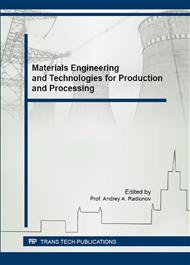p.195
p.203
p.208
p.213
p.217
p.225
p.231
p.236
p.242
Ground Granulated Blast-Furnace Slag and its Activation Methods
Abstract:
. The ground granulated slag is a wide spread component of various types of cement and binding substances. Its pozzolanic activity depends on different factors. It is searched out, that there are no minerals able to liquid maturing in the slag under consideration, the slag activity data according to domestic and foreign standards specifies it as low-active, third rate. Altering the chemical composition to a small degree, specific to a definite type of slag, does not alter its functioning much. The same stands for the slag dispersiveness at the high rate of amorphous state – the dispersiveness rise increases slag activity and water demand, and more dispersed slag does not increase the resistibility of matrix samples in high-flow concrete mix. Thus, this type of slag is supposed to be grounded up to BET surface area equal to 250-300 m2/kg, compared to dispersive capacity СEM 1, and the substitution of a part of cement by slag would not have a significant ifluence on mix water demand. With the increase in the slag content within the cementing component the slag effectiveness index increases and reaches its maximum at 70% cement replacement by slag. A large portion of slag can substantially decrease the hydration of lime in the hardened cement paste of the concrete and lessen the solidity of reinforcement corrosion protection in concrete structures. The article deals with different methods of ground granulated blastfurnace slag activation within the mixed cementing substance: Portland-cement CEM1 + GGBFS. The most widely used way of activation – the usage of sodium and potassium alkalies and liquid glass is quite effective, but it demands expensive artificial components, while the alkali compounds forming at hardening of such a cementing component would be soluble.
Info:
Periodical:
Pages:
217-224
Citation:
Online since:
February 2016
Authors:
Price:
Сopyright:
© 2016 Trans Tech Publications Ltd. All Rights Reserved
Share:
Citation:


